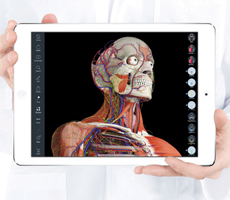
With its November launch of the iPad Pro, Apple is working to make the tablet more accessible to the healthcare industry. The tablet features a 12.9-inch viewing surface and 64-bit processor, as well as add-on capabilities that include a stylus and detachable keyboard.
The company said these will make the device more tenable to work on than a smartphone, and less clunky to lug around than small laptops.
During its Sept. 14 launch party for the device, Apple also announced a partnership with Ireland-based tech company 3D4Medical, which has developed a group of apps that use 3D technology to provide clinicians, medical students and researchers with a high-definition, animated model of the human body. The apps, which will be available on the new iPad Pro, allow physicians and nurses to show a patient exactly what’s happening in his or her body, honing in on a medically compromised area, such as ruptured ligaments or tendons, broken or fractured bones, wounds such as pressure or foot ulcers, diseased organs or even the specific size and shape of bone spurs for an arthritic patient.
The use of iPads in long-term care facilities has been gaining momentum. Much of the progress has been in more therapy-related settings for capturing the treatment delivered, the time spent on each activity, and other relevant clinical information, said Janaka Dias, chief information officer with Kindred Rehabilitation Services’ RehabCare division. Dias says his company’s use of iPads in the field has allowed therapists to help patients improve and have better clinical outcomes. They’re also using the device for patient education.
“Our mobile app has made quick deployment possible, so our clinicians can do so many things at their fingertips,” he said. “Currently, we’re looking at implementing an exercise app that provides individualized exercises to patients before they are discharged.”
From the November 01, 2015 Issue of McKnight's Long-Term Care News



